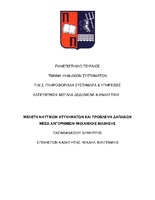Μελέτη ναυτικών ατυχημάτων και πρόβλεψη δαπανών μέσω αλγορίθμων μηχανικής μάθησης

View/
Keywords
Analytics ; Machine learning ; Supervised machine learning algorithms ; Binary classification problem ; ForecastingAbstract
Like all business entities, shipping companies are called upon to act for profitability, which is how well a company utilizes its resources in the purpose to generate profit and shareholder value. The onboard human resources are the most essential factor that ensures a smooth and planned course of a business voyage, which is the main activity of a shipping company. Due to the complex environment and unforeseen circumstances that characterize a voyage, the shipping company is constantly on the alert and must be ready to manage, the new data and the new situation. Sudden accidents that happen on merchant ships are part of the unforeseen and unexpected events and can have a direct impact on the ship's course as well as the overall performance of the voyage. The main goal of this master thesis is to study the theoretical and experimental algorithms of supervised machine learning using the R programmatic environment. The final goal is to develop and deploy valuable forecasting models that predict the importance of accidents occurring during a voyage of a merchant ship, which is a key feature of predicting the required total treatment cost. In general, prediction is one of the core points of interest in machine learning field with a wide range of research. The application of the forecast is carried out in various scientific majors such as medicine, meteorology, biology as well as the industry, such as the automobile industry, insurance companies, banks, etc. with various practical applications. In the shipping industry, the use of forecasting models is also widespread, but there is no prior application to the subject
of the present master thesis. Primarily we will study the behavior and the performance of the applied machine learning algorithms and then enhance its performance through optimization techniques. Finally, we will compare the results and extract the analogous results.


